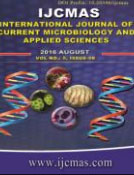


 National Academy of Agricultural Sciences (NAAS)
National Academy of Agricultural Sciences (NAAS)

|
PRINT ISSN : 2319-7692
Online ISSN : 2319-7706 Issues : 12 per year Publisher : Excellent Publishers Email : editorijcmas@gmail.com / submit@ijcmas.com Editor-in-chief: Dr.M.Prakash Index Copernicus ICV 2018: 95.39 NAAS RATING 2020: 5.38 |
The Ntomba mbodi is a food who is consumed in the Republic of Congo. It is obtained by fermentation of cassava leaves. During the fermentation of cassava leaves develop several genera or species of fermentative bacteria. However other non-fermentative bacteria may be present. In order to study microbial diversity in the fermentation of cassava leaves, Staphylococci and Micrococci were isolated and their physiological and biochemical characteristics were followed during growth. The identification of Staphylococci and Micrococci was made from the cultural characters. The various staphylococci were identified were using API Staph gallery. The tube culture method was used to determine the respiratory type. Bacterial growth was followed as a function of pH and NaCl concentration. These parameters were analyzed as a function of fermentation time. The identification results are given: 100% Microcuccus spp. 50%, Staphylococcus sciuri, 40% of Staphylococcus xylosus and respectively 5% of Staphylococcus chromogen and Staphylococcus lentus. The research of respiratory type gave the following breakdown: , 64.5% of bacteria were strict aerobic and 35.5% aerobic-anaerobic. The determination of the growth parameters showed that strains grow at alkaline pH 8.6 and tolerate effective 15% NaCl. However, some strains are tolerant of acidic pH (pH 3.5) and grow at low salt concentrations.
 |
 |
 |
 |
 |